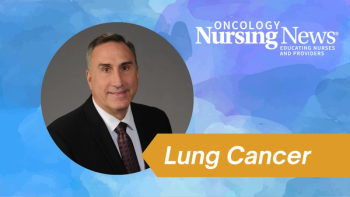
Trilaciclib Efficacy in the Prevention of CIM in ES-SCLC
Renowned leaders in thoracic oncology discuss efficacy data from key clinical trials that led to the FDA approval of the CDK4/6 inhibitor trilaciclib for CIM prophylaxis in ES-SCLC, including the drug’s role in later treatment lines.
Episodes in this series

Transcript:
Martin Dietrich, MD, PhD: Dr Santos, could you walk us through the different settings where trilaciclib [Cosela] has been tested in both the first and second-line setting of small cell lung cancer [SCLC]? Could you give us a bit of an overview as to what the impact was and what the clinical trial populations looked like?
Edgardo Santos, MD, FACP: Trilaciclib [Cosela], which is an intravenous CDK4/6 inhibitor with a short half-life, has been studied extensively for use in small cell lung cancer as a first-line and second-line therapy. There are 3 studies. One was done on patients with extensive-disease small-cell lung cancer who were exposed to chemotherapy. You mentioned before carboplatin [Paraplatin] plus etoposide [Toposar] as a standard of care worldwide. There was a primary end point and a secondary end point looking for severe neutropenia and the duration of severe neutropenia. There were other secondary end points needed for secondary prophylaxis. The amount of transfusion, if needed, is a secondary analysis.
There was a second study done on the same population, but this time on patients who also received immunotherapy¾in this case, atezolizumab [Tecentriq]. As we know, chemotherapy-immunotherapy is the standard of care today for first-line extensive disease in small cell lung cancer and with similar primary and secondary end points. The first study was on the second line for patients who progress after a platinum-based doublet. They went on to receive topotecan, which is another agent we use in the second line. Those regimens, carboplatin-etoposide and carboplatin-etoposide plus immunotherapy—in this case, atezolizumab [Tagrisso] and topotecan—carry a high risk of myelosuppression.
In this study, and in those 3 phase 2 studies, the patient received the therapy, trilaciclib [Cosela], and another group received the placebo. We found that severe neutropenia and the duration of the severe neutropenia was significantly in favor of those who received trilaciclib vs patients who received the placebo. Similarly, in a descriptive manner on the secondary end point, the amount of transfusion¾of red blood cells or platelets, as well as the amount of anemia¾seen on those patients was also less in patients who received trilaciclib [Cosela] vs the group that received the placebo.
Because of these data, the pool analysis of these 3 clinical trials that I just presented, the FDA approved trilaciclib [Cosela] for the indication to avoid chemotherapy-induced myelosuppression. Today trilaciclib [Cosela] is the only myeloprotection we have to treat patients with cancer. We’d like to move this compound, this CDK4/6 inhibitor, to other clinical therapies, not only for small cell lung cancer. How can we protect these hematopoietic stem cells?
Martin Dietrich, MD, PhD: Edgardo, could you comment on the outcomes, and the efficacy differences we’re seeing between the patients receiving placebo vs patients treated with trilaciclib [Cosela]? Were there any signals seen?
Edgardo Santos, MD, FACP: For patients who responded to trilaciclib [Cosela], 1 advantage is avoiding a problem with myelosuppression, avoiding use of this growth factor support, or avoiding the worst-case scenario: the patient ending up in the hospital. There are some scenarios in which a patient who responded to trilaciclib [Cosela] also has some T-cell clonal expansion, because you’re protecting the hematopoietic stem cells. Some studies have also reported that we’re helping the immunologic effect against the cancer. I consider that very important. By doing that, we also kill the intensity of the regimen, so we don’t have to do dose reduction.
Martin Dietrich, MD, PhD: I’ve seen fewer dose delays and less dose-reduction efficacy. This speaks to the differentiating impact of this regimen on cancer cells vs bone marrow cells.
Edgardo Santos, MD, FACP: That’s correct.
Martin Dietrich, MD, PhD: Dr Santos, you spoke about the first-line setting use of trilaciclib [Cosela] prior to platinum-etoposide treatment in the first-line setting. How do you see the role of topotecan [Hycamtin] in second- or later-line settings? What’s your approach there?
Edgardo Santos, MD, FACP: The problem we have in extensive-disease small-cell lung cancer is that the disease grows so fast. Then in the second line¾and sometimes third line on patients who can receive third line¾patients are more compromised and the therapies are more myelosuppressive than in the first line, unfortunately. We have a rate of neutropenia of 70% or 80% when we move to second-line therapy for small cell lung cancer. Something like trilaciclib [Cosela], which we can provide the patient ahead of time, can protect hematopoietic progenitor cells. That’s the beauty. We’re living in an era where if we have something that can help us, we can be proactive and not reactive because once the patient gets neutropenia, a lot of things could happen.
We’re going to give growth factor support. Similarly, if the patient gets chemotherapy anemia, the same thing happens—either growth factor support or sometimes transfusion—so we can keep up with the pace of the therapy. There’s no question in my mind that with a high incidence of neutropenia in second- or third-line therapy for small cell lung cancer, trilaciclib [Cosela] needs to be on board as a myeloprotectant to avoid this issue.
Martin Dietrich, MD, PhD: I’m hearing you say that the need may be even bigger in a later-line setting.
Edgardo Santos, MD, FACP: Absolutely. Yes.
Martin Dietrich, MD, PhD: We do the same in our practice. We’re trying to preempt, especially in neutropenic complications, but we shouldn’t underestimate the impact on quality of life from anemia and other myelosuppressive impacts that we see.
Transcript edited for clarity.
Newsletter
Knowledge is power. Don’t miss the most recent breakthroughs in cancer care.
































































































